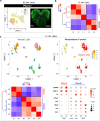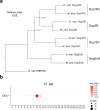A single-cell transcriptomic atlas tracking the neural basis of division of labour in an ant superorganism
- PMID: 35711063
- PMCID: PMC9349048
- DOI: 10.1038/s41559-022-01784-1
A single-cell transcriptomic atlas tracking the neural basis of division of labour in an ant superorganism
Abstract
Ant colonies with permanent division of labour between castes and highly distinct roles of the sexes have been conceptualized to be superorganisms, but the cellular and molecular mechanisms that mediate caste/sex-specific behavioural specialization have remained obscure. Here we characterized the brain cell repertoire of queens, gynes (virgin queens), workers and males of Monomorium pharaonis by obtaining 206,367 single-nucleus transcriptomes. In contrast to Drosophila, the mushroom body Kenyon cells are abundant in ants and display a high diversity with most subtypes being enriched in worker brains, the evolutionarily derived caste. Male brains are as specialized as worker brains but with opposite trends in cell composition with higher abundances of all optic lobe neuronal subtypes, while the composition of gyne and queen brains remained generalized, reminiscent of solitary ancestors. Role differentiation from virgin gynes to inseminated queens induces abundance changes in roughly 35% of cell types, indicating active neurogenesis and/or programmed cell death during this transition. We also identified insemination-induced cell changes probably associated with the longevity and fecundity of the reproductive caste, including increases of ensheathing glia and a population of dopamine-regulated Dh31-expressing neurons. We conclude that permanent caste differentiation and extreme sex-differentiation induced major changes in the neural circuitry of ants.
© 2022. The Author(s).
Conflict of interest statement
The authors declare no competing interests.
Figures














Comment in
-
Complementary brains.Nat Ecol Evol. 2022 Aug;6(8):1060-1061. doi: 10.1038/s41559-022-01805-z. Nat Ecol Evol. 2022. PMID: 35711064 No abstract available.
Similar articles
-
The gene expression network regulating queen brain remodeling after insemination and its parallel use in ants with reproductive workers.Sci Adv. 2020 Sep 16;6(38):eaaz5772. doi: 10.1126/sciadv.aaz5772. Print 2020 Sep. Sci Adv. 2020. PMID: 32938672 Free PMC article.
-
Canalized gene expression during development mediates caste differentiation in ants.Nat Ecol Evol. 2022 Nov;6(11):1753-1765. doi: 10.1038/s41559-022-01884-y. Epub 2022 Oct 3. Nat Ecol Evol. 2022. PMID: 36192540 Free PMC article.
-
From Egg to Adult: A Developmental Table of the Ant Monomorium pharaonis.J Exp Zool B Mol Dev Evol. 2024 Dec;342(8):557-585. doi: 10.1002/jez.b.23278. J Exp Zool B Mol Dev Evol. 2024. PMID: 39584621
-
Caste development and evolution in ants: it's all about size.J Exp Biol. 2017 Jan 1;220(Pt 1):53-62. doi: 10.1242/jeb.145292. J Exp Biol. 2017. PMID: 28057828 Review.
-
Social complexity and brain evolution: insights from ant neuroarchitecture and genomics.Curr Opin Insect Sci. 2022 Oct;53:100962. doi: 10.1016/j.cois.2022.100962. Epub 2022 Aug 24. Curr Opin Insect Sci. 2022. PMID: 36028191 Review.
Cited by
-
Single-cell transcriptomics reveals the brain evolution of web-building spiders.Nat Ecol Evol. 2023 Dec;7(12):2125-2142. doi: 10.1038/s41559-023-02238-y. Epub 2023 Nov 2. Nat Ecol Evol. 2023. PMID: 37919396 Free PMC article.
-
Identification of ecdysone receptor target genes in the worker honey bee brains during foraging behavior.Sci Rep. 2023 Jun 28;13(1):10491. doi: 10.1038/s41598-023-37001-7. Sci Rep. 2023. PMID: 37380789 Free PMC article.
-
Evolution at the cellular level.Nat Ecol Evol. 2023 Aug;7(8):1155-1156. doi: 10.1038/s41559-023-02133-6. Nat Ecol Evol. 2023. PMID: 37400516 No abstract available.
-
Single-nucleus and spatial transcriptomics identify brain landscape of gene regulatory networks associated with behavioral maturation in honeybees.Nat Commun. 2025 Apr 8;16(1):3343. doi: 10.1038/s41467-025-58614-8. Nat Commun. 2025. PMID: 40199930 Free PMC article.
-
Multi-Omics Analysis Reveals TO Gene's Association With Food Selection and Lifespan in Minor-Worker Ants Post-Queen Loss.Ecol Evol. 2025 Jun 7;15(6):e71508. doi: 10.1002/ece3.71508. eCollection 2025 Jun. Ecol Evol. 2025. PMID: 40486941 Free PMC article.
References
-
- Wheeler, W. M. Ants: Their Structure, Development and Behavior (Columbia Univ. Press, 1910).
-
- Wheeler WM. The ant‐colony as an organism. J. Morphol. 1911;22:307–325. doi: 10.1002/jmor.1050220206. - DOI
Publication types
MeSH terms
LinkOut - more resources
Full Text Sources

